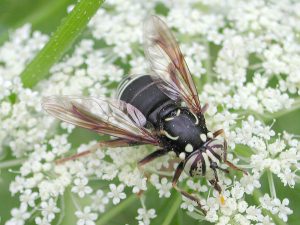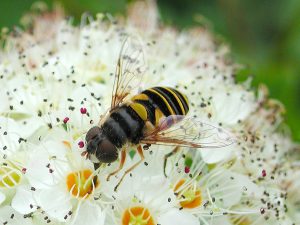Back to Innovator Next article Previous article
Written by: OSCIA provincial office
Agriculture and Agri-Food Canada (AAFC)’s Living Lab Initiative is an integrated approach that brings together farmers, agricultural organizations, conservation authorities, and scientists from AAFC and Environment and Climate Change Canada (ECCC) to co-develop innovations and conduct scientific research to test and monitor them on working farms. The Ontario Soil and Crop Improvement Association leads the groups working with AAFC and ECCC on Living Lab-Ontario (LL-ON) to help more than sixty scientists conduct research on farms, with farmers. One of those research projects is looking at habitat for native pollinators.
The importance of pollinators for crop production and ecosystem health is well known. Approximately 85% of flowering plants and 35% of food crops are pollinated by insects. Most of the crop pollination in Canada is done by native pollinators, not honeybees. Canada has more than 800 bee species and thousands of fly species that are important pollinators. For example, flower flies (Syrphidae) pollinate more than 100 cultivated plant species and are responsible for up to two thirds of canola pollination in Canada. In addition to pollination services, many flies also provide pest control; numerous species are predatory and stealthily hunt aphids or other soft-bodied insects that damage crops.
Unfortunately, we know little about the habitat requirements of our native bees and flies. Through the LL-ON project, Dr. Lauren Des Marteaux, AAFC, Harrow and Dr. Jeff Skevington, AAFC, Ottawa are collaborating with researchers from the University of Guelph and the Canadian Wildlife Federation to identify the habitats and plants that support pollinator diversity and abundance on farms. Their objective is to improve agricultural landscapes for better pollination services and sustainability by increasing native pollinator populations to enhance crop production, increase pest control, and lower costs for farmers.
Farms are working landscapes, and it was important to focus on landscape features occurring on most farms such as forest patches, hedgerows, and grassy field margins. To ensure that the findings are useful to farmers, the research occurred on 21 farms across Essex and Norfolk counties, including the farms of LL-ON cooperators Henry Denotter, Ken Laing, and Greg Vermeersch.
Insects were collected from the farms using sweep nets and Malaise traps. Malaise traps are tent like traps strategically placed to capture flying insects and preserve them in ethanol. Sixty Malaise traps were set up on farm hedgerows, forest patches, and field margins. Every three days from May to July 2021, research students collected insects from the traps. They collected 1,140 samples, each containing tens of thousands of insects representing 1,500 to 2,000 species. In total the traps yielded 19.6 kilograms of insects.
Samm Reynolds, a PhD candidate at University of Guelph, is completing the painstaking work of sorting and identifying the species using identification keys and microscopes and DNA sequencing. This information will be entered into a database to develop a score based on the abundance and diversity of pollinator flies and bees at each farm and habitat feature.
In addition to the collection of insects, plant surveys were done within the grassy field margins, hedgerows, and forest patches at each sampling location. The plant surveys will be correlated with the pollinators collected to develop an overall diversity score. When the results are complete the researchers will identify which habitat feature and plant community had the most pollinator species diversity and abundance.
The information will determine the importance of forest patches, hedgerows, and grassy field margins in supporting beneficial pollinators. The findings will help producers identify and enhance habitat features to increase pollinator presence on their farms.

M.Sc. student Samantha Reynolds with collaborator Andrew Young and a Malaise trap.
When the research findings are available later this year, OSCIA will collaborate with the scientists and farmers to get feedback on the findings and recommendations. After all, the whole point of a Living Lab is to create solutions together to ensure that the practices will be adopted.
To learn more about Living Lab Ontario visit:
Living Lab OSCIA (https://www.osciaresearch.org/living-lab/).








